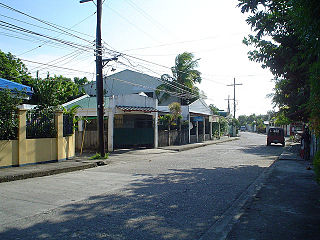
Iloilo City, officially the City of Iloilo, is a 1st class highly urbanized city on Panay Island in Western Visayas (Region VI), Philippines. It is the capital city of the province of Iloilo where it is geographically situated but, in terms of government and administration, it is politically independent. In addition, it is the center of the Iloilo-Guimaras Metropolitan Area, as well as the regional center and primate city of the Western Visayas region. In the 2015 census, Iloilo City had a population of 447,992 inhabitants, with a 1.02% population annual growth rate. For the metropolitan area, the total population is 946,146 inhabitants.

Mandurriao is one of the seven districts of Iloilo City, located in the Philippines. It is bounded by Molo to the south and west, City Proper to the south and east, and La Paz to the north.
The legislative district of Abra is the representation of the province of Abra in the various national legislatures of the Philippines. The province is currently represented in the lower house of the Congress of the Philippines through its lone congressional district.
The legislative districts of Cebu are the representations of the province of Cebu and the highly urbanized city of Mandaue in the various national legislatures of the Philippines. The province and city are currently represented in the lower house of the Congress of the Philippines through their first, second, third, fourth, fifth, sixth, and seventh congressional districts.
The legislative districts of Agusan del Sur are the representations of the province of Agusan del Sur in the various national legislatures of the Philippines. The province is currently represented in the lower house of the Congress of the Philippines through its first and second congressional districts.
The legislative district of Aurora is the representation of the province of Aurora in the various national legislatures of the Philippines. The province is currently represented in the lower house of the Congress of the Philippines through its lone congressional district.
The legislative districts of Albay are the representations of the province of Albay in the various national legislatures of the Philippines. The province is currently represented in the lower house of the Congress of the Philippines through its first, second, and third congressional districts.
The legislative districts of Bataan are the representations of the province of Bataan in the various national legislatures of the Philippines. The province is currently represented in the lower house of the Congress of the Philippines through its first and second congressional districts.
The legislative district of Benguet is the representation of the province of Benguet in the various national legislatures of the Philippines. The province is currently represented in the lower house of the Congress of the Philippines through its lone congressional district.
The legislative districts of Ilocos Norte are the representations of the province of Ilocos Norte in the various national legislatures of the Philippines. The province is currently represented in the lower house of the Congress of the Philippines through its first and second congressional districts.
The legislative districts of Ilocos Sur are the representations of the province of Ilocos Sur in the various national legislatures of the Philippines. The province is currently represented in the lower house of the Congress of the Philippines through its first and second congressional districts.
The legislative districts of Cebu City are the representations of the highly urbanized city of Cebu in the various national legislatures of the Philippines. The city is currently represented in the lower house of the Congress of the Philippines through its first and second congressional districts.
The legislative districts of Leyte are the representations of the province of Leyte, the independent component city of Ormoc, and highly urbanized city of Tacloban in the various national legislatures of the Philippines. The province, together with the independent cities are currently represented in the lower house of the Congress of the Philippines through their first, second, third, fourth, and fifth congressional districts.
The legislative districts of Iloilo are the representations of the province of Iloilo in the various national legislatures of the Philippines. The province is currently represented in the lower house of the Congress of the Philippines through its first, second, third, fourth and fifth congressional districts.
The legislative districts of Cotabato are the representations of the province of Cotabato in the various national legislatures of the Philippines. The province is currently represented in the lower house of the Congress of the Philippines through its first, second, and third congressional districts.
The legislative districts of Cagayan are the representations of the province of Cagayan in the various national legislatures of the Philippines. The province is currently represented in the lower house of the Congress of the Philippines through its first, second, and third congressional districts.
The legislative districts of Laguna are the representations of the province of Laguna in the various national legislatures of the Philippines. The province is currently represented in the lower house of the Congress of the Philippines through its first, second, third, and fourth congressional districts.
The legislative districts of Misamis Occidental are the representations of the province of Misamis Occidental in the various national legislatures of the Philippines. The province is currently represented in the lower house of the Congress of the Philippines through its first and second congressional districts.
The legislative districts of Misamis Oriental are the representations of the province of Misamis Oriental in the various national legislatures of the Philippines. The province is currently represented in the lower house of the Congress of the Philippines through its first and second congressional districts.
The legislative district of Lapu-Lapu is the representation of the highly urbanized city of Lapu-Lapu in the Congress of the Philippines. The city is currently represented in the lower house of the Congress through its lone congressional district.


